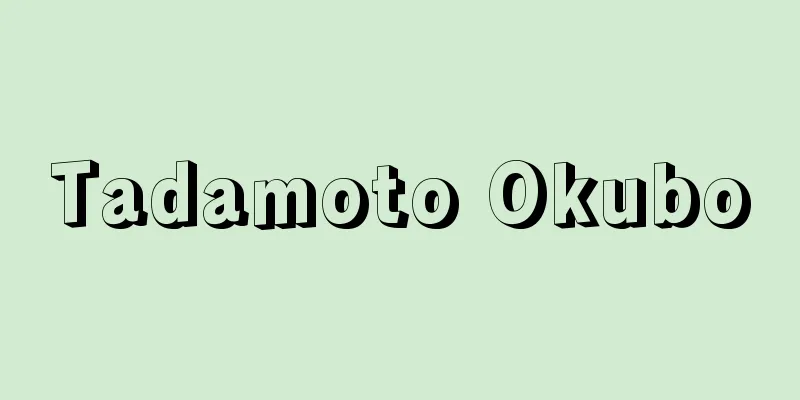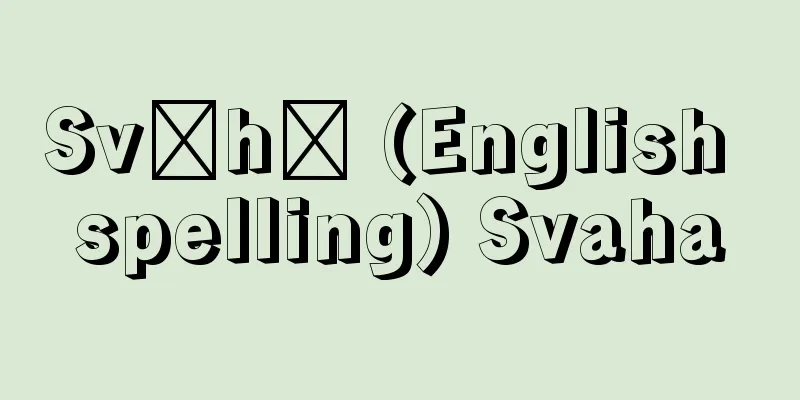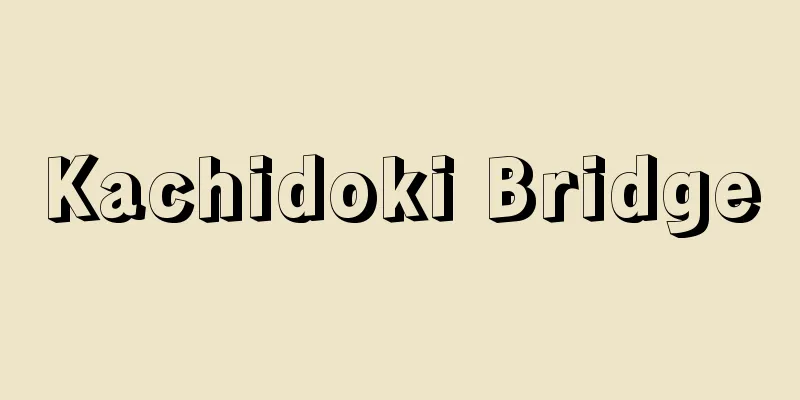Jiuta - Jiuta

|
A type of shamisen music. It is also written as jiuta. It was established in Kyoto and Osaka at the end of the 16th century, and later developed into a major genre of Japanese music by blind professional musicians such as kengyo (masterless samurai) and koutou (masterless samurai) who were members of the Todo shokuyashiki system. Until recent years, it was mainly performed in homes and rooms, and in Edo it was also called kamigatauta (Kamigata songs). Originally, it was music sung to accompany the shamisen (the name for the shamisen in jiuta), but since these musicians also played the koto (Japanese harp) and kokyu (Japanese fiddle), it eventually began to be performed in ensembles with these instruments. In particular, for tegotomono pieces, it became common to perform them as a trio of shamisen, koto, and shakuhachi after the Meiji period. On the other hand, it has absorbed other forms of music besides the original jiuta, such as theatrical songs and joruri, and has come to have a rich variety of songs. There is also a type of dance called jiuta-mai, in which jiuta is used as the ji (accompaniment music). Usually hauta pieces are performed, but sometimes tegotomono pieces, which are shortened versions of the tegoto section, are used. [Kiyoshi Inobe] Songs and historyThe oldest type of music is the Honde group (Omote group) of "Shamisen Kumiuta" composed by Ishimura and Torazawa Kengyo (?-1654) from the end of the 16th century to the beginning of the 17th century. This includes seven pieces, including "Ryukyu group". Later, Torazawa and Yanagawa Kengyo (?-1680) created the Hade group. Currently, they are classified into Omote, Hade, Ura group, Nakayurushi, and Oyoroshi (Oku group), with several pieces being handed down in the Yanagawa school and a total of 32 pieces being handed down in the Nogawa school. The standard form is a combination of six or seven short songs, including non-coherent popular songs and dance songs of the time, with the tempo changing from slow to fast. Its distinctive features include the insertion of interjections and the repeated playing of the morobachi (double plectrum) pattern in the front section. In contrast to these kumiuta, 'choutamono', which are songs with a consistent content, appeared. They were composed by Sayama (?-1694), Asari (?-1698), Ichikawa (years of birth and death unknown), Onogawa (years of birth and death unknown), Ikuta, Nogawa (?-1717), Tsuguhashi (years of birth and death unknown), Utaki (years of birth and death unknown), Fujibayashi (years of birth and death unknown), Fujinaga Kengyo (years of birth and death unknown), and Asatsuma Koto (?-1690). Some of these have long interjections within the piece, and are sometimes classified as tegotomono. Around the same time, some pieces that were sung on the kabuki stage in Kyoto and Osaka were incorporated into jiuta and have been passed down since. These "shibai-uta" were mainly written by sighted people such as Kishino Jiroza (years of birth and death unknown), Koide Kinshiro (?-1720), and Yamamoto Kiichi (years of birth and death unknown). In addition, "utaimono" pieces based on Noh themes were written by Kishino Jiroza and Fujio Koto (years of birth and death unknown), some of which overlap with shibai-uta. On the other hand, Utaki, Tamaoka Kengyo (years of birth and death unknown), Tsuruyama (years of birth and death unknown), and Minezaki Koto produced "ha-utamono," short but highly sensitive and artistic pieces. There are many representative masterpieces of jiuta, including Minezaki's "Yuki." In addition, hage-utamono in a broad sense can also be used to include shibai-uta and utaimono. Furthermore, the interludes of Nagauta and other songs were lengthened and had song sections before and after, that is, "tegotomono" which is composed of a musical form of maeuta (introduction song) - tegoto - atouta (end song) became popular. Minezaki and Mitsuhashi Koto (date of birth and death unknown) of Osaka, Matsuura, Kikuoka, Mitsuzaki Kengyo, and Ishikawa Koto (date of birth and death unknown) of Kyoto composed many masterpieces. Among them, a series of elegant pieces created in Kyoto from the Bunka and Bunsei eras (1804-1830) onwards are called Kyoto-style tegotomono and have been widely performed to this day. Among these, large-scale pieces appeared in which tegoto appeared two or three times, such as maebiki (introduction song) - maeuta - tegoto - nakauta - tegoto - atouta (end song). The tegoto itself also took a complex form, starting with a tsunagi or makura, and followed by a chirashi after the tegoto. And it became common for them to be played together with the koto. Yaezaki Kengyo, Ichiura (date of birth and death unknown), Kawarazaki Kengyo (date of birth and death unknown), and others left their names in posterity for their koto hand-playing. Some joruri pieces have been absorbed into jiuta, but these are valuable because they have disappeared as schools today. Representative examples of such "jorurimono" are Eikanbushi, Shigetayu-bushi, whose melodies were used by Kakuyama Koto and others, and Handayu-bushi, which mainly features Sogamono, which inherited the melodies of Edo Handayu. In addition to the above, there is also "sakumono" (dokemono), which has humorous content and is in the style of storytelling with a strong sense of improvisation. In this way, jiuta developed, giving rise to a large number of different songs, but from around the end of the Edo period, its creativity rapidly declined and it eventually entered the era of tradition. [Kiyoshi Inobe] Style and performanceThe Yanagawa school, which began with Yanagawa Kengyo, is based in Kyoto, while the Nogawa school, which began with Nogawa Kengyo, is centered in Osaka. Furthermore, in Kyoto, there are divisions based on place of residence, such as the Kami school, Shimo school, and Fushimi school, and in Osaka, there are divisions based on place of residence, such as the Kita school, Minami school, Kikuji school, Nakaji school, Tomisuji school, and Tateji school, with somewhat different traditions. In addition, the Kyushu school is also influential, and these various lineages have advanced into Tokyo since the Meiji period. When jiuta was first established, shamisen had a thin neck, but gradually it evolved into something unique to each region. In Osaka in particular, it was played with a thin, wide-open bachi and a wide-set bridge, and a tone similar to that of the gidayu shamisen was preferred. Meanwhile, in Kyoto, some performers still use the Kyo shamisen (Yanagawa shamisen), which has a very thin neck, a bamboo skin, and is played with a small Kyo bachi, resulting in a unique tone. However, in recent years, Kyushu-style shamisen have almost taken over the country. As a result, the distinctive, individual tones of each region have been lost. As for jiuta performers, Tomizaki Shunsho of the Ikuta school was recognized as a holder of an Important Intangible Cultural Property (Living National Treasure) in 1955 (Showa 30), followed by the first Toyama Seikin (now Seio) from Tokyo, Kikuhara Hatsuko from Osaka, and Fujii Kunie (1930/1933-2006) of the Ikuta school. [Kiyoshi Inobe] [References] | | | | | | | | |Source: Shogakukan Encyclopedia Nipponica About Encyclopedia Nipponica Information | Legend |
|
三味線音楽の一種目。地唄(じうた)とも書く。16世紀末には京坂の地で成立しており、その後、当道職屋敷制度に属する検校(けんぎょう)、勾当(こうとう)らの盲人職業音楽家によって、日本音楽の一大ジャンルに発展した。近年になるまでは、もっぱら家庭内や座敷で演奏され、江戸では上方唄(かみがたうた)とも称した。本来は三絃(さんげん)(地歌における三味線の呼称)を伴って歌う音楽であったが、これら音楽家は箏(こと)や胡弓(こきゅう)もあわせ弾くところから、やがてそれらの楽器との合奏も行われるようになった。とくに手事物(てごともの)の曲では、明治以後、三絃・箏・尺八の三曲合奏で演奏されるのが一般化した。その一方では、本来の地歌以外の芝居歌や浄瑠璃(じょうるり)などを吸収して、豊富な曲種をもつに至った。なお、地唄舞と称する、地歌を地(伴奏音楽)として舞う舞踊がある。普通は端歌(はうた)物を演奏するが、ときに手事部分を短縮した手事物を用いることもある。 [井野辺潔] 曲種と歴史最古の曲種は、16世紀末から17世紀初めにかけて石村(いしむら)・虎沢(とらざわ)検校(?―1654)によってつくられた「三味線組歌」の本手組(ほんでぐみ)(表(おもて)組)である。これには『琉球(りゅうきゅう)組』など7曲がある。その後、虎沢・柳川(やながわ)検校(?―1680)らにより破手(はで)組ができた。現在、表・破手・裏組・中許(なかゆるし)・大許(奥組)に分類され、柳川流では数曲が、野川流では全32曲が伝えられている。標準的な形は、互いに一貫性のない当時の流行(はやり)唄や躍(おどり)歌など6、7首の短い歌を組み合わせたもので、緩から急へテンポが移ってゆく。間投詞を挿入したり、表組では双撥(もろばち)の音型を反覆して弾いたりするなどの特徴がある。 こうした組歌に対して、一貫した内容の一つの歌である「長歌物」が出現する。佐山(?―1694)・浅利(?―1698)・市川(生没年不詳)・小野川(生没年不詳)・生田(いくた)・野川(?―1717)・継橋(つぐはし)(生没年不詳)・歌木(生没年不詳)・藤林(生没年不詳)・藤永検校(生没年不詳)、朝妻勾当(?―1690)らにより作曲された。これらのうちには、曲中に長い合の手をもつものがあり、手事物に分類されることもある。相前後して、京坂の歌舞伎(かぶき)の舞台で歌われた曲が地歌に摂取され、伝えられているものもある。これらの「芝居歌」は岸野次郎三(きしのじろさ)(生没年不詳)、湖出(こいで)金四郎(?―1720)、山本喜市(生没年不詳)ら、主として晴眼者の手になった。また、一部は芝居歌とも重複するが、能を題材とした「謡い物」の曲が岸野次郎三、藤尾勾当(生没年不詳)らによってつくられた。その一方、歌木・玉岡検校(生没年不詳)、鶴山(つるやま)(生没年不詳)・峰崎勾当らは、短いが感性豊かで芸術性に富む「端歌物」を生み出した。峰崎の『雪』をはじめ地歌の代表的名曲が少なくない。なお、芝居歌や謡物を含めて、広義の端歌物とする場合もある。 さらには長歌などの合の手を長大化し、前後に歌の部分をもつ、すなわち前歌(まえうた)―手事―後歌(あとうた)の楽曲形式で構成する「手事物」が盛んとなる。大坂の峰崎・三ッ橋勾当(生没年不詳)ら、京都の松浦・菊岡・光崎(みつざき)検校、石川勾当(生没年不詳)らは、名曲の数々を作曲した。なかでも文化・文政(ぶんかぶんせい)期(1804~1830)以降の、京都で生まれた一連の優美な曲は、京流手事物とよばれ、今日まで盛んに演奏されてきた。これらのうちには、前弾(まえびき)―前歌―手事―中歌―手事―後歌というふうに、手事が2回、3回と現れる大規模な曲も出現した。手事自体もツナギやマクラで始まり、手事のあとチラシがつく複雑な形式をとったりする。そして、たいていは箏の手が付けられて合奏するのが普通となった。八重崎(やえざき)検校を筆頭に、市浦(生没年不詳)・河原崎検校(生没年不詳)らは、箏の手付けで後世に名前を残した。 地歌のなかには、浄瑠璃のいくつかが吸収されているが、これらは、今日では流派としては滅亡しているので貴重である。そうした「浄瑠璃物」としては永閑節(えいかんぶし)や、鶴山勾当らがその旋律を援用した繁太夫(しげたゆう)節、江戸半太夫の旋律を継承した曽我(そが)物を主とする半太夫(はんだゆう)節が代表的である。以上のほかに、滑稽(こっけい)な内容で、即興性の強い語物風の「作物(さくもの)」(おどけもの)もある。このように数多の曲種を生んで発展した地歌であったが、幕末ごろからは急速に創造力を低下させ、やがて伝承時代へ入っていった。 [井野辺潔] 流派と演奏柳川検校に始まる柳川流が京都で、野川検校に始まる野川流が大阪を中心に伝統を伝えている。さらに京都では、上(かみ)派、下(しも)派、伏見(ふしみ)派といった居住地による別があり、大阪でも北派、南派とか、菊筋、中筋、富筋、楯(たて)筋などで伝承を幾分異にしている。そのほか九州系も有力で、東京へは明治以後に、これら各系統が進出していった。 地歌が成立した当初は、棹(さお)の細い三絃であったが、しだいに各地独自のものに分化していった。とくに大阪では、先端が薄くて大きく開いた撥(ばち)で弾き、台広(だいびろ)の駒(こま)を使用して、義太夫の三味線に近い音色が好まれた。一方、京都では現在も一部の演奏家の間で、ごく細い棹で、八ッ乳(ち)の皮を張り、小さな京撥で弾く、独特の音色をもつ京三味線(柳川三味線)が用いられている。しかし、近年は九州系の三絃がほぼ全国を制覇している。その結果、特色ある各地の個性的音色が失われることにもなった。 なお、地歌の演奏家としては、1955年(昭和30)に生田流の富崎春昇(しゅんしょう)が重要無形文化財保持者(人間国宝)に認定されたのを初めに、東京の初世富山清琴(せいきん)(現、清翁(せいおう))と大阪の菊原初子(はつこ)、生田流の藤井久仁江(1930/1933―2006)がそれぞれ認定されている。 [井野辺潔] [参照項目] | | | | | | | | | |出典 小学館 日本大百科全書(ニッポニカ)日本大百科全書(ニッポニカ)について 情報 | 凡例 |
Recommend
Hatano style
The name of a school of Heikyoku. In the Edo perio...
Drosophila melanogaster - Drosophila
A general term for flies belonging to the family D...
Metasomatic deposit
A deposit formed by metasomatism. Skarn-type depo...
Gesta Danorum (English spelling)
…He attempted to pacify the Baltic Sea region, wh...
Toyotama [town] - Toyotama
A former town in Shimoagata County, Nagasaki Prefe...
Alien - Space Alien
It refers to life forms with intelligence similar...
Land allotment system
In the narrow sense, it is sometimes used synonymo...
Trichodesmium
A filamentous colonial cyanobacterium that lives a...
Ishizuke - Ishizuke
A trap for catching fish. A depression is dug in a...
Harem - Koukyuu
It is similar to the inner palace of the emperor ...
Wilton, Joseph
Born: July 16, 1722, London [Died] November 25, 18...
hoard
…In European archaeology, this refers to ruins an...
Neptune (mythology) (English spelling) Neptune
…He was also the god of earthquakes and horses. H...
Colostomy
An artificial anus (stoma) is constructed when th...
Nokogiriyama - Nokogiriyama
This mountain is located in the southern part of ...


![Heilongjiang [Province] - Heilongjiang](/upload/images/67cb923342d41.webp)



![Teradomari [town] - Teradomari](/upload/images/67cc465cc459b.webp)


